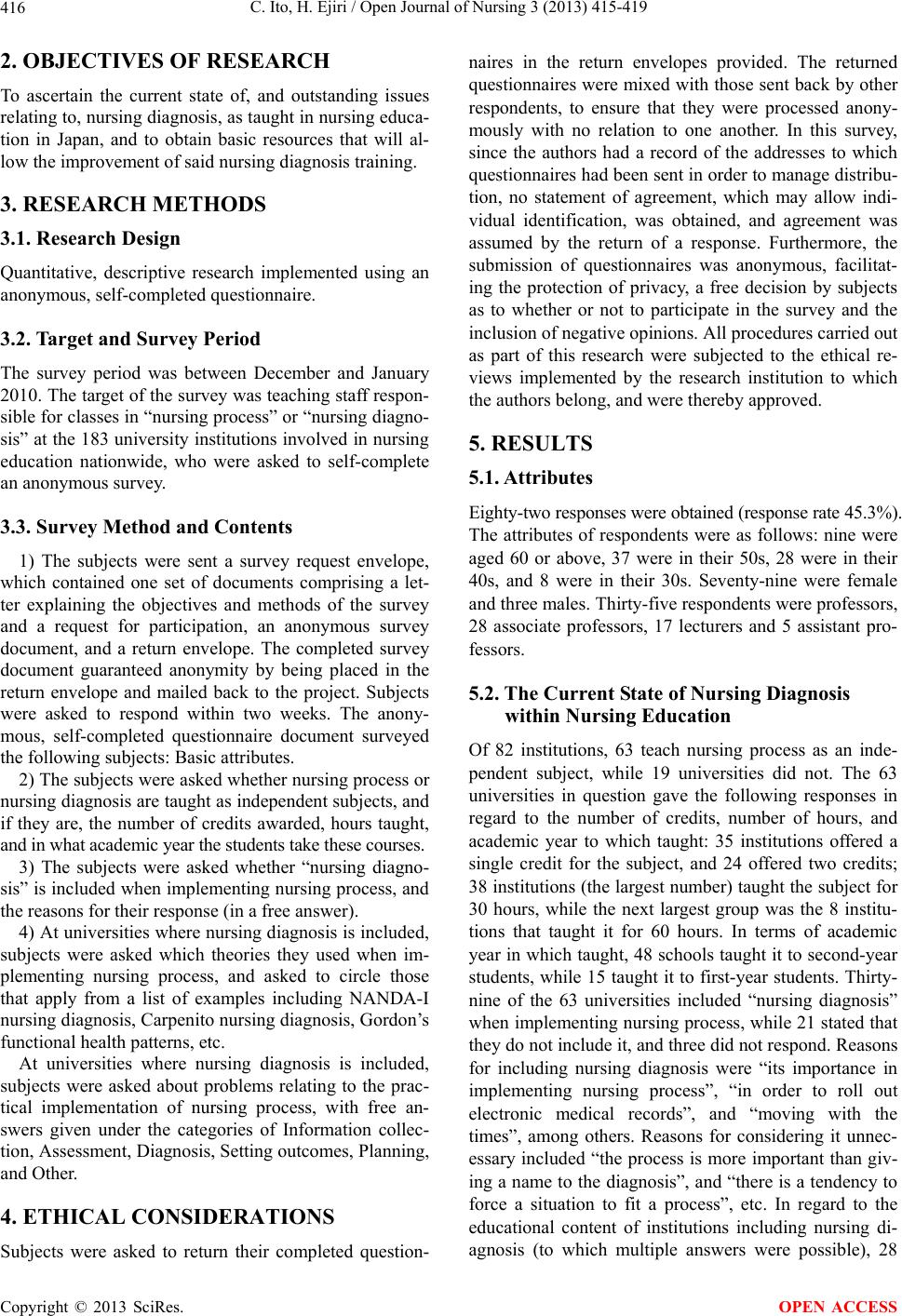
C. Ito, H. Ejiri / Open Journal of Nursing 3 (2013) 415-419
416
2. OBJECTIVES OF RESEARCH
To ascertain the current state of, and outstanding issues
relating to, nursing diagnosis, as taught in nursing educa-
tion in Japan, and to obtain basic resources that will al-
low the improvement of said nursing d iagnosis training.
3. RESEARCH METHODS
3.1. Research Design
Quantitative, descriptive research implemented using an
anonymous, self-completed questionnaire.
3.2. Target and Survey Period
The survey period was between December and January
2010. The target of the survey was teaching staff respon-
sible for classes in “nursing process” or “nursing diagno-
sis” at the 183 university institutions invo lved in nursing
education nationwide, who were asked to self-complete
an anonymous survey.
3.3. Survey Method and Contents
1) The subjects were sent a survey request envelope,
which contained one set of documents comprising a let-
ter explaining the objectives and methods of the survey
and a request for participation, an anonymous survey
document, and a return envelope. The completed survey
document guaranteed anonymity by being placed in the
return envelope and mailed back to the project. Subjects
were asked to respond within two weeks. The anony-
mous, self-completed questionnaire document surveyed
the following subjects: Basic attributes.
2) The subjects were asked whether nursing process or
nursing diag nosis are taught as independ ent subjects, and
if they are, the number of credits awarded, hours taught,
and in what academic year the students take these courses.
3) The subjects were asked whether “nursing diagno-
sis” is included when implementing nursing process, and
the reasons for their response (in a free answer).
4) At universities where nursing diagnosis is included,
subjects were asked which theories they used when im-
plementing nursing process, and asked to circle those
that apply from a list of examples including NANDA-I
nursing diagnosis, Carpen ito n ursing d iagnosis, Go rdo n’s
functional health pattern s, etc.
At universities where nursing diagnosis is included,
subjects were asked about problems relating to the prac-
tical implementation of nursing process, with free an-
swers given under the categories of Information collec-
tion, Assessment, Diagnosis, Setting outcomes, Planning,
and Other.
4. ETHICAL CONSIDERATIONS
Subjects were asked to return their completed question-
naires in the return envelopes provided. The returned
questionnaires were mixed with those sent back by other
respondents, to ensure that they were processed anony-
mously with no relation to one another. In this survey,
since the authors had a record of the addresses to which
questionnaires had been sent in order to manage distribu-
tion, no statement of agreement, which may allow indi-
vidual identification, was obtained, and agreement was
assumed by the return of a response. Furthermore, the
submission of questionnaires was anonymous, facilitat-
ing the protection of privacy, a free decision by subjects
as to whether or not to participate in the survey and the
inclusion of negat i ve opinions. Al l procedures carried out
as part of this research were subjected to the ethical re-
views implemented by the research institution to which
the authors belong, and were thereby approved.
5. RESULTS
5.1. Attributes
Eighty-two responses were obtained (response rate 45.3%).
The attributes of respondents were as follows: nine were
aged 60 or above, 37 were in their 50s, 28 were in their
40s, and 8 were in their 30s. Seventy-nine were female
and three males. Thirty-five respondents were professors,
28 associate professors, 17 lecturers and 5 assistant pro-
fessors.
5.2. The Current State of Nursing Diagnosis
within Nursing Education
Of 82 institutions, 63 teach nursing process as an inde-
pendent subject, while 19 universities did not. The 63
universities in question gave the following responses in
regard to the number of credits, number of hours, and
academic year to which taught: 35 institutions offered a
single credit for the subject, and 24 offered two credits;
38 institutions (the largest number) taught the subject for
30 hours, while the next largest group was the 8 institu-
tions that taught it for 60 hours. In terms of academic
year in which taught, 48 schools taught it to second -year
students, while 15 taught it to first-year students. Thirty-
nine of the 63 universities included “nursing diagnosis”
when imple menting nursing pro cess, while 21 stated that
they do not include it, and three did not respond. Reasons
for including nursing diagnosis were “its importance in
implementing nursing process”, “in order to roll out
electronic medical records”, and “moving with the
times”, among others. Reasons for considering it unnec-
essary included “the process is more important than giv-
ing a name to the diagnosis”, and “there is a tendency to
force a situation to fit a process”, etc. In regard to the
educational content of institutions including nursing di-
agnosis (to which multiple answers were possible), 28
Copyright © 2013 SciRes. OPEN ACCESS